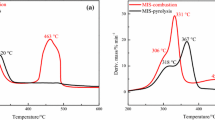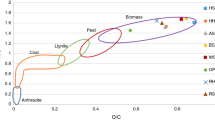Abstract
The co-combustion characteristics of oily sludge and ginkgo leaves (GL) in an oxy-fuel atmosphere are investigated via thermogravimetric analysis coupled with an artificial neural network. The combustion characteristics of blends improve as the GL mass ratio increases. The interaction indices used to evaluate the interaction between the two solid combustibles present a complex nonlinear relationship in different stages. The Flynn-Wall-Ozawa and Kissinger-Akahira-Sunose methods are used to calculate the activation energy of the blends, which increases with an increase in the oxygen concentration, in different atmospheres. Compared with the radial basis function, the backpropagation neural network performs better in predicting the combustion curve of the blends.
Similar content being viewed by others
References
Li J, Lin F, Xiang L, et al. Hazardous elements flow during pyrolysis of oily sludge. J Hazard Mater, 2021, 409: 124986
Bao D, Li Z, Liu X, et al. Biochar derived from pyrolysis of oily sludge waste: Structural characteristics and electrochemical properties. J Environ Manage, 2020, 268: 110734
Cheng S, Wang Y, Gao N, et al. Pyrolysis of oil sludge with oil sludge ash additive employing a stirred tank reactor. J Anal Appl Pyrolysis, 2016, 120: 511–520
Xie C, Liu J, Buyukada M, et al. Parametric assessment of stochastic variability in co-combustion of textile dyeing sludge and shaddock peel. Waste Manage, 2019, 96: 128–135
Yang R, Ma C, Chen G, et al. Study on NOx emission during corn straw/sewage sludge co-combustion: Experiments and modelling. Fuel, 2021, 285: 119208
Deng S, Wang X, Tan H, et al. Thermogravimetric study on the Co-combustion characteristics of oily sludge with plant biomass. ThermoChim Acta, 2016, 633: 69–76
Lin Y, Ma X, Ning X, et al. TGA-FTIR analysis of co-combustion characteristics of paper sludge and oil-palm solid wastes. Energy Convers Manage, 2015, 89: 727–734
Xie C, Liu J, Zhang X, et al. Co-combustion thermal conversion characteristics of textile dyeing sludge and pomelo peel using TGA and artificial neural networks. Appl Energy, 2018, 212: 786–795
Lu K M, Lee W J, Chen W H, et al. Thermogravimetric analysis and kinetics of co-pyrolysis of raw/torrefied wood and coal blends. Appl Energy, 2013, 105: 57–65
Xiao R, Yang W, Cong X, et al. Thermogravimetric analysis and reaction kinetics of lignocellulosic biomass pyrolysis. Energy, 2020, 201: 117537
Zhu X, Yu S, Xu K, et al. Sustainable activated carbons from dead ginkgo leaves for supercapacitor electrode active materials. Chem Eng Sci, 2018, 181: 36–45
Panahi A, Sirumalla S K, West R H, et al. Temperature and oxygen partial pressure dependencies of the coal-bound nitrogen to NOx conversion in O2/CO2 environments. Combust Flame, 2019, 206: 98–111
Tu Y, Xu M, Zhou D, et al. CFD and kinetic modelling study of methane MILD combustion in O2/N2, O2/CO2 and O2/H2O atmospheres. Appl Energy, 2019, 240: 1003–1013
Luo J, Zou C, He Y, et al. The characteristics and mechanism of NO formation during pyridine oxidation in O2/N2 and O2/CO2 atmospheres. Energy, 2019, 187: 115954
Yi B, Zhang L, Huang F, et al. Effect of H2O on the combustion characteristics of pulverized coal in O2/CO2 atmosphere. Appl Energy, 2014, 132: 349–357
Liu Y, Cheng J, Zou C, et al. Ignition delay times of ethane under O2/CO2 atmosphere at different pressures by shock tube and simulation methods. Combust Flame, 2019, 204: 380–390
Lai Z Y, Ma X Q, Tang Y T, et al. A study on municipal solid waste (MSW) combustion in N2/O2 and CO2/O2 atmosphere from the perspective of TGA. Energy, 2011, 36: 819–824
Chen J, Xie C, Liu J, et al. Co-combustion of sewage sludge and coffee grounds under increased O2/CO2 atmospheres: Thermodynamic characteristics, kinetics and artificial neural network modeling. Bioresource Tech, 2018, 250: 230–238
Qiu C, Yi Y K, Wang M, et al. Coupling an artificial neuron network daylighting model and building energy simulation for vacuum photovoltaic glazing. Appl Energy, 2020, 263: 114624
Yang R, Xiong R, Ma S, et al. Characterization of external short circuit faults in electric vehicle Li-ion battery packs and prediction using artificial neural networks. Appl Energy, 2020, 260: 114253
Yang S, Wan M P, Chen W, et al. Experiment study of machine-learning-based approximate model predictive control for energy-efficient building control. Appl Energy, 2021, 288: 116648
Li C. Designing a short-term load forecasting model in the urban smart grid system. Appl Energy, 2020, 266: 114850
Han Y, Fan C, Geng Z, et al. Energy efficient building envelope using novel RBF neural network integrated affinity propagation. Energy, 2020, 209: 118414
Zhang T, Zhang D, Yan H, et al. A new method of data missing estimation with FNN-based tensor heterogeneous ensemble learning for internet of vehicle. Neurocomputing, 2021, 420: 98–110
Chen J, Liu J, He Y, et al. Investigation of co-combustion characteristics of sewage sludge and coffee grounds mixtures using thermogravimetric analysis coupled to artificial neural networks modeling. Bioresource Tech, 2017, 225: 234–245
Hai A, Bharath G, Daud M, et al. Valorization of groundnut shell via pyrolysis: Product distribution, thermodynamic analysis, kinetic estimation, and artificial neural network modeling. Chemosphere, 2021, 283: 131162
Buyukada M, Aydogmus E. Utilization of apricot seed in (co-)combustion of lignite coal blends: Numeric optimization, empirical modeling and uncertainty estimation. Fuel, 2018, 216: 190–198
Xie W, Wen S, Liu J, et al. Comparative thermogravimetric analyses of co-combustion of textile dyeing sludge and sugarcane bagasse in carbon dioxide/oxygen and nitrogen/oxygen atmospheres: Thermal conversion characteristics, kinetics, and thermodynamics. Bioresource Tech, 2018, 255: 88–95
Mundike J, Collard F X, Görgens J F. Co-combustion characteristics of coal with invasive alien plant chars prepared by torrefaction or slow pyrolysis. Fuel, 2018, 225: 62–70
Li X, Miao W, Lv Y, et al. TGA-FTIR investigation on the co-combustion characteristics of heavy oil fly ash and municipal sewage sludge. ThermoChim Acta, 2018, 666: 1–9
Deng S, Tan H, Wang X, et al. Investigation on the fast co-pyrolysis of sewage sludge with biomass and the combustion reactivity of residual char. Bioresource Tech, 2017, 239: 302–310
Wang Q, Zhao W, Liu H, et al. Interactions and kinetic analysis of oil shale semi-coke with cornstalk during co-combustion. Appl Energy, 2011, 88: 2080–2087
Das P, Mondal D, Maiti S. Thermochemical conversion pathways of Kappaphycus alvarezii granules through study of kinetic models. Bioresource Tech, 2017, 234: 233–242
Li J, Qiao Y, Zong P, et al. Fast pyrolysis characteristics of two typical coastal zone biomass fuels by thermal gravimetric analyzer and down tube reactor. Bioresource Tech, 2019, 283: 96–105
Ahmad R, Mohd Ishak M A, Kasim N N, et al. Properties and thermal analysis of upgraded palm kernel shell and Mukah Balingian coal. Energy, 2019, 167: 538–547
Niu S, Yu H, Zhao S, et al. Apparent kinetic and thermodynamic calculation for thermal degradation of stearic acid and its esterification derivants through thermogravimetric analysis. Renew Energy, 2019, 133: 373–381
Yıldız Z, Uzun H, Ceylan S, et al. Application of artificial neural networks to co-combustion of hazelnut husk-lignite coal blends. Bioresource Tech, 2016, 200: 42–47
Huang J, Xiao Q, Liu J, et al. Modeling heat transfer properties in an ORC direct contact evaporator using RBF neural network combined with EMD. Energy, 2019, 173: 306–316
Xie Z, Ma X. The thermal behaviour of the co-combustion between paper sludge and rice straw. Bioresource Tech, 2013, 146: 611–618
Tahmasebi A, Kassim M A, Yu J, et al. Thermogravimetric study of the combustion of Tetraselmis suecica microalgae and its blend with a Victorian brown coal in O2/N2 and O2/CO2 atmospheres. Bioresource Tech, 2013, 150: 15–27
Liu C, Liu J, Sun G, et al. Thermogravimetric analysis of (co-)combustion of oily sludge and litchi peels: Combustion characterization, interactions and kinetics. ThermoChim Acta, 2018, 667: 207–218
Chen W H, Wang C W, Ong H C, et al. Torrefaction, pyrolysis and two-stage thermodegradation of hemicellulose, cellulose and lignin. Fuel, 2019, 258: 116168
Senneca O, Cerciello F, Heuer S, et al. Slow pyrolysis of walnut shells in nitrogen and carbon dioxide. Fuel, 2018, 225: 419–425
Gao Y, Tahmasebi A, Dou J, et al. Combustion characteristics and air pollutant formation during oxy-fuel co-combustion of microalgae and lignite. Bioresource Tech, 2016, 207: 276–284
Zhao R, Qin J, Chen T, et al. Experimental study on co-combustion of low rank coal semicoke and oil sludge by TG-FTIR. Waste Manage, 2020, 116: 91–99
Author information
Authors and Affiliations
Corresponding author
Additional information
This work was supported by the National Natural Science Foundation of China (Grant No. 51876106), the Primary Research & Development Plan of Shandong Province, China (Grant No. 2018GGX104027), and the Young Scholars Program of Shandong University (Grant No. 2015WLJH33).
Rights and permissions
About this article
Cite this article
Li, S., Niu, S., Han, K. et al. Investigating the co-combustion characteristics of oily sludge and ginkgo leaves through thermogravimetric analysis coupled with an artificial neural network. Sci. China Technol. Sci. 65, 261–271 (2022). https://doi.org/10.1007/s11431-021-1959-0
Received:
Accepted:
Published:
Issue Date:
DOI: https://doi.org/10.1007/s11431-021-1959-0




